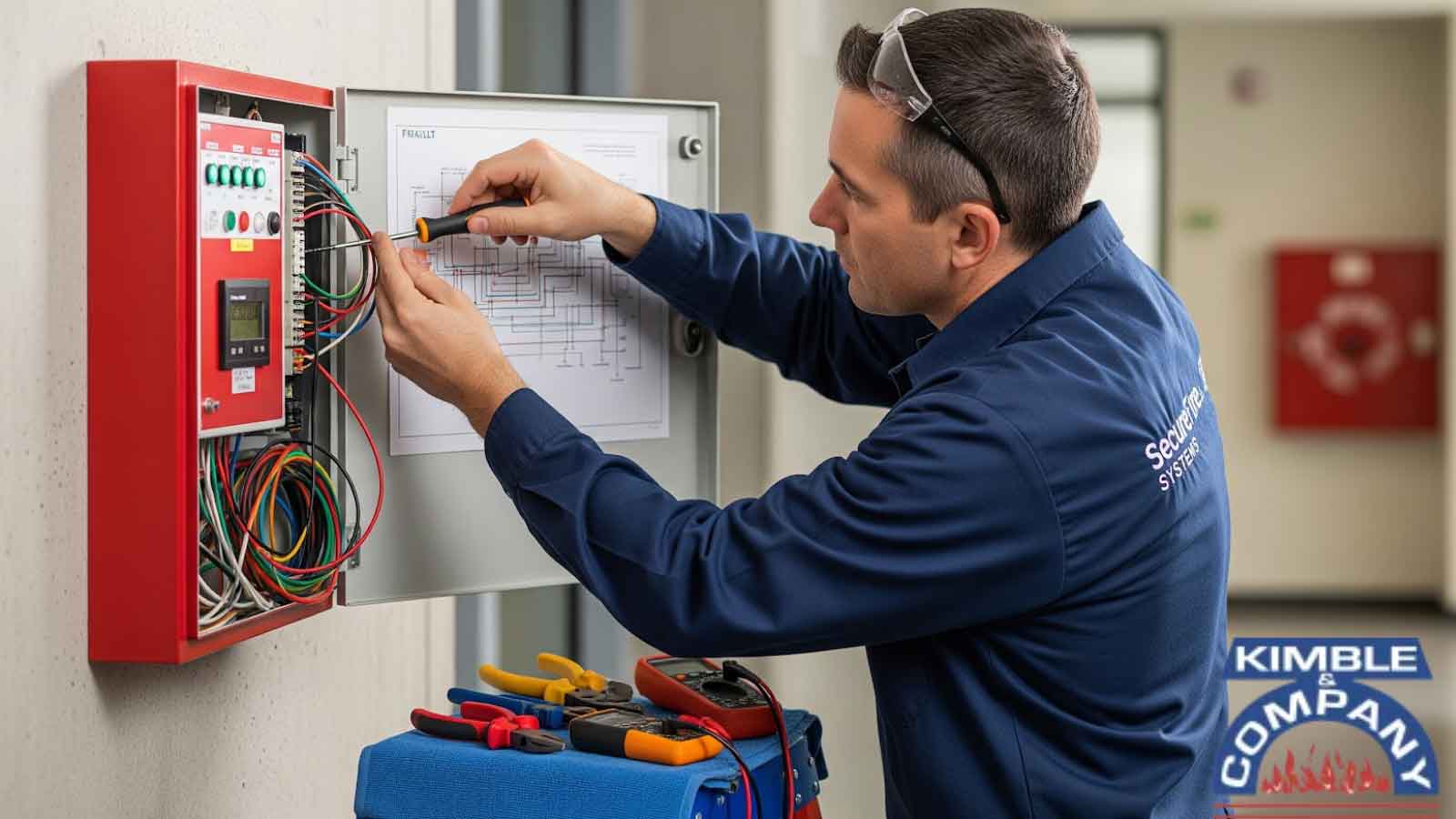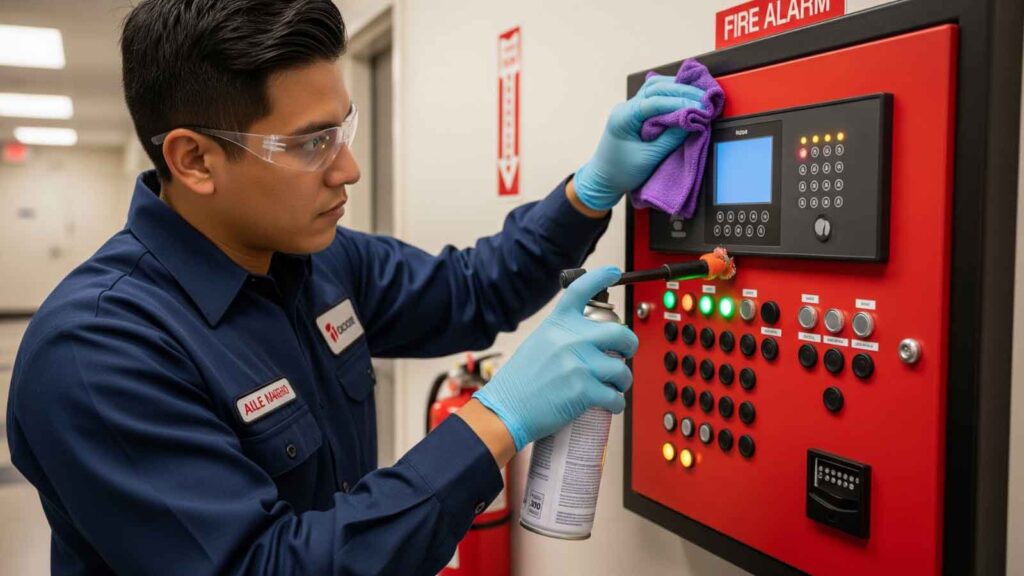If your fire alarm system keeps going off for no apparent reason, you’re not alone. It’s one of the most common issues building managers face, and it can be both stressful and disruptive.
While these alarms are designed to protect people and property, frequent false alerts often point to simpler issues, such as environmental changes or overdue maintenance.
The good news? Most causes are easy to fix once you understand the basics of how fire alarms detect issues and respond to changes in your environment.
Common Reasons Your Fire Alarm Keeps Going Off
Fire alarm sensors continuously sample air and conditions, sending signals to the control panel whenever readings exceed set thresholds. In connected commercial systems, one misread can ripple across the network.
The issues below are the most common reasons those thresholds get tripped. False alarms can occur for several reasons, but most are attributed to a few predictable factors.
Understanding these not only helps you solve the problem quickly but also ensures your alarm system remains dependable and compliant. Each cause below explains what’s really happening and what to do next to prevent repeat activations.
Environmental Triggers Like Dust, Steam, or Humidity
Even minor changes in the air can make a detector react as if there’s smoke. Commercial buildings with kitchens, restrooms, or machinery often produce steam, dust, or humidity that confuses sensors. When these particles enter the detector, they scatter light beams or block airflow, tricking the system into thinking a fire is starting.
Keeping detectors away from areas with high moisture content and ensuring proper ventilation significantly reduces the likelihood of false triggers.
- Steam and humidity mimic smoke: Steam from kitchens, restrooms, or industrial spaces can refract light inside the sensor, making it register as smoke. This is common in restaurants, gyms, and manufacturing sites with high moisture. Relocating detectors a few feet away or improving airflow can resolve the issue immediately.
- Dust and debris cause misreads: Fine particles from renovation or cleaning can coat the detector chamber, disrupting how sensors read air quality. These particles make the system more sensitive than intended, causing it to alarm even in normal conditions. Cover detectors during dusty work and clean them afterward to prevent this.
- Insects or lint interfere with older detectors: Small insects or fibers can enter detectors through ventilation holes, blocking sensors and mimicking smoke density. This is more common in older devices that lack insect screens or filters. Regular cleaning after your fire alarm installation helps maintain precise sensors and reliable performance.
- Good habits make the difference: A clean environment helps sensors distinguish between real hazards and harmless particles. Consistent cleaning schedules and attention to airflow keep detectors performing accurately. When in doubt, a technician can assess the placement to ensure each detector is fitted properly in its location.
Low Batteries or Power Issues
The reliability of your fire alarm depends on a steady power supply. Even small fluctuations in energy supply can confuse the system’s sensors and control panels, leading to false alerts. Both battery-operated and hardwired systems are vulnerable if voltage levels change unexpectedly. Regular monitoring ensures your alarm operates smoothly without unnecessary activations.
- Weak batteries confuse the system: When backup batteries begin to weaken, they produce inconsistent voltage that detectors interpret as an error. This triggers a warning chirp or, in some cases, a full alarm. Replacing batteries annually ensures steady performance and avoids these signal errors.
- Power surges interrupt the signal: Surges from nearby equipment or unstable electricity can overload circuits for a split second, causing detectors to send false alerts. Using surge protectors for alarm panels shields the system from these short disruptions. It’s especially important in facilities with heavy machinery or frequent power fluctuations.
- Inconsistent current causes false signals: A flicker or brief outage can interrupt communication between detectors and the main panel. This miscommunication can trigger multiple alarms simultaneously, even without smoke or heat. Inspecting power connections helps confirm whether the issue stems from wiring or unstable current.
- Simple checks go a long way: Routine testing of power supplies and backup systems ensures consistent voltage and responsiveness. These small steps take just minutes but prevent hours of unnecessary downtime caused by false alarms. Keeping a maintenance log also helps track patterns that could signal electrical problems.
Sensor or Equipment Malfunctions
Fire alarm systems are built to last, but like any equipment, they age. Over time, sensors lose calibration, wiring loosens, and control panels may struggle to communicate with newer components.
When that happens, the system begins to misread inputs and send false alerts. Identifying worn parts early prevents both disruption and unnecessary replacements.
- Old sensors lose accuracy: Sensors gradually become less precise as dust, temperature shifts, or age affect their internal mechanisms. Once sensitivity drifts out of range, detectors begin to react to harmless particles. Replacing or recalibrating them restores normal detection levels and prevents future issues.
- Wiring issues send mixed signals: Vibrations, renovations, or minor electrical faults can loosen wiring, breaking the steady signal between detectors and the main panel. This incomplete transmission often triggers alarms without any real cause. Checking and securing wiring ensures clean communication and consistent responses.
- Control panels age too: Outdated panels may not interpret signals from newer detectors correctly, causing random activations or delayed alarms. Upgrading to a compatible model eliminates these mismatches and boosts reliability. Modern panels also provide more accurate diagnostics for early fault detection.
- Call in the experts when needed: If the alarms persist after cleaning and battery changes, it’s time for professional fire protection services. Trained technicians can test circuits, check sensor alignment, and ensure every device meets safety codes. Expert evaluation prevents deeper issues that DIY fixes might miss.
How to Fix and Prevent False Fire Alarms
Once you’ve identified what’s triggering the alarms, the next step is to establish a simple routine that maintains your system’s reliability.
Prevention doesn’t require complex tools or deep technical knowledge, just consistency, awareness, and care. By following these steps, you can stop small issues from turning into costly disruptions.
- Clean Detectors the Right Way: Over time, dust and fine debris accumulate inside sensors, distorting their readings of the air. Use compressed air or a soft, dry brush to gently remove buildup without damaging components. Avoid using liquids, sprays, or wipes; moisture can alter the detector’s sensitivity and cause new false triggers. Setting a monthly reminder for a quick clean is an easy way to keep sensors performing optimally.
- Replace Backup Batteries Annually: Replace all backup batteries yearly to prevent voltage fluctuations that cause false alarms. Doing this ensures consistent power delivery and avoids the signal inconsistencies that often trigger random alarms or chirps. Labeling replacement dates helps track schedules easily and keeps every component in sync. This simple preventive step maintains steady operation across your entire system.
- Check Detector Placement: The location has a significant impact on the system’s performance. Sensors placed near kitchens, restrooms, or HVAC vents are more likely to pick up steam, heat, or airflow changes that mimic smoke. Moving detectors just a few feet away from these areas can eliminate most environmental false alarms. If you’re unsure about placement, a technician can recommend the ideal positioning for your building layout.
- Inspect Wiring Connections: Inspect wiring connections periodically to ensure detectors communicate cleanly with the control panel. This proactive check keeps signals stable, prevents random activations, and supports long-term reliability. Scheduling these inspections alongside regular maintenance helps catch minor issues early before they cause larger disruptions.
- Book Your Annual Professional Check: A certified technician should inspect your system at least once a year to ensure all parts are functioning as intended. During a professional fire alarm inspection, they’ll test sensors, recalibrate detection levels, and verify compliance with local fire codes.
This service helps catch hidden faults that routine cleaning or maintenance might miss. Having documented inspection records also demonstrates compliance during safety audits and insurance reviews.
Why Modern Fire Alarm Technology Makes All the Difference
Today’s commercial fire alarm systems do more than sound alerts; they use smart sensors, wireless connectivity, and real-time monitoring to make buildings safer and more efficient.
Unlike older models that rely solely on heat or smoke detection, newer systems analyze air quality patterns and adjust sensitivity automatically. This reduces false alarms while ensuring fast detection when real danger appears.
Upgraded systems also help property managers stay connected. Through mobile alerts or building management dashboards, you can receive instant notifications if a detector is triggered or a component needs attention. That means quicker responses, fewer disruptions, and peace of mind knowing you’re always in the loop, even when you’re off-site.
Investing in newer technology also simplifies future expansions. Whether you’re adding new floors, updating your HVAC system, or renovating older areas, modern alarm networks adapt easily without major rewiring.
These scalable systems not only improve safety but also help meet evolving building codes and insurance standards.
Read Also: Choosing the Right Fire Protection System for Your Building
Key Takeaway: Prevention Is the Best Fix
Most false alarms don’t start as big problems; they begin as minor oversights, like a dusty sensor or a neglected system check. Left unaddressed, those minor issues can interrupt your business and weaken your overall safety setup.
The easiest way to stay ahead is by keeping things simple: incorporate cleanliness, awareness, and consistency into your safety routine.
Being proactive is far more effective than reacting to the same alarm repeatedly. When you understand how your system works and stay alert to changes in your environment, you can stop disruptions before they happen. That’s what real fire preparedness looks like: calm, steady, and reliable.
If you’re ready to make your fire protection system more reliable, contact Kimble & Company today.


